An Ángel Di María free-kick, a rare goal from Danilo Pereira and a not-so-rare brace from Kylian Mbappé fired Paris Saint-Germain to a dominant 4-2 win over Ligue 1 title rivals Lyon on Sunday evening. With fellow title challengers Lille suffering a surprise 2-1 loss to relegation-battling Nîmes Olympique, PSG now sit atop Ligue 1 at the end of a game-week for the first time since January.
Meanwhile, Lyon, who went into Sunday’s game level on points with Les Parisiens, now sit three points off the top spot and just one point ahead of fourth-place Monaco, putting them in a precarious position for even achieving UEFA Champions League qualification.
“We can’t lose so many duels. It’s impossible to do that and succeed against PSG” were the words of a dejected Rudi Garcia in his post-match press conference on Sunday. The Lyon manager made it clear that he felt his side lacked athleticism over the course of Sunday’s defeat. Mauricio Pochettino, on the other hand, was understandably full of praise for his side and their “really good” performance that put them top of France’s top-flight.
In this tactical analysis, we’ll provide some analysis of Lyon and PSG’s tactics from Sunday’s Ligue 1 clash. We’ll examine some strengths and weaknesses to both teams’ tactics, in and out of possession, to determine what Lyon really were lacking on Sunday, and what tactical features played a role in propelling PSG to a dominant victory.
Lineups and formations
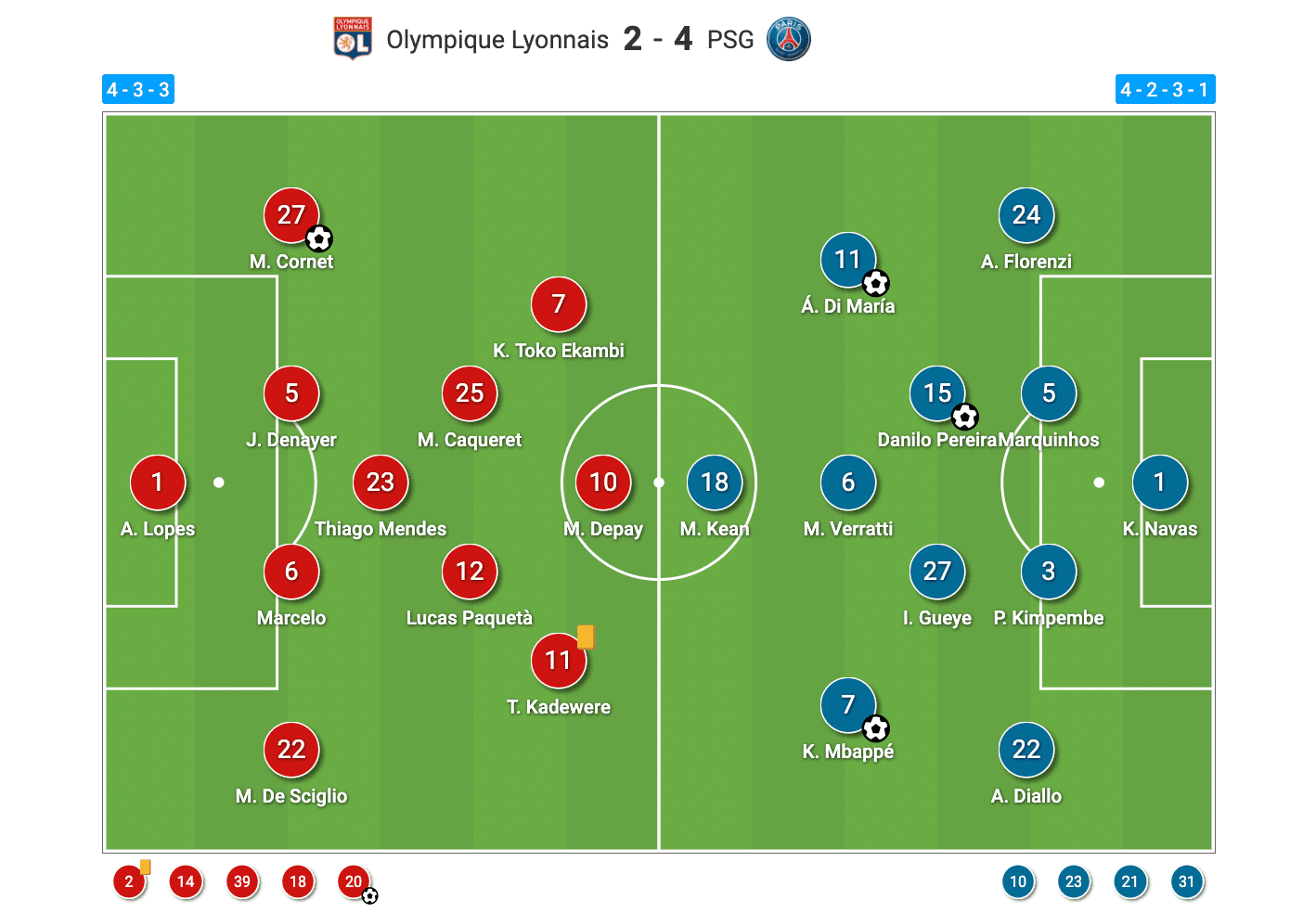
Firstly, we’ll look at how both teams lined up at the weekend. Starting with the hosts, Lyon lined up in a 4-3-3 shape. Anthony Lopes played in goal, behind a back four consisting of right-back Mattia De Sciglio, on-loan from Serie A giants Juventus, left-back Maxwel Cornet, right centre-back Marcelo and left centre-back Jason Denayer.
Thiago Mendes started at the base of midfield, in front of the centre-backs and behind the central midfield duo of Maxence Caqueret and Lucas Paquetá. Les Gones’ regular front three of Karl Toko Ekambi, Tino Kadewere and Memphis Depay completed the hosts’ starting XI.
Just over 10 minutes into the second half, Depay, Kadewere and Mendes all left the pitch, with Léo Dubois, Islam Slimani and Bruno Guimarães replacing them. Dubois slotted in at right-back, with De Sciglio moving to left-back, Cornet pushing up to left-wing and Toko Ekambi taking Kadewere’s place on the right side of attack. Guimarães replaced Mendes at the base of midfield and Slimani took Depay’s place at the head of the attack.
As the second half wore on, Rayan Cherki took Toko Ekambi’s place on the right and Lyon’s last substitution came in the 77th minute, as Sinaly Diomandé came on for Denayer at left centre-back.
As for the visitors, they lined up in a 4-2-3-1 shape for this one. Keylor Navas started in goal, while similar to Lyon, a man on loan from Serie A – this time from Roma, rather than Juve – played at right-back in the form of Alessandro Florenzi. Abdou Diallo started at left-back, Presnel Kimpembe started at left centre-back and Marquinhos started at right centre-back.
Danilo Pereira, on loan from Liga NOS side Porto, started alongside Idrissa Gueye at the base of PSG’s midfield, while Dí María, Marco Verratti and Mbappé started just behind striker Moise Kean, who’s on loan at PSG from Premier League Everton.
Like the hosts, PSG made some changes in personnel during the game. At the 70-minute mark, Neymar came on for Mbappé, while later on in the second half, Ander Herrera replaced Gueye and Colin Dagba replaced Florenzi. All of these changes were straight swaps, unlike Lyon’s. Lastly, Julian Draxler replaced Kean in second-half stoppage time, with the German enjoying a cameo appearance to help his side to see out this victory despite Lyon threatening to make a late resurgence.
Lyon’s defensive tactics
Now we’ll provide some analysis of Lyon’s defensive tactics from this 4-2 loss to PSG. Les Parisiens’ gameplan in possession was tailored to exploit potential weaknesses in Lyon’s defensive tactics and they executed that gameplan very effectively. So, before looking at how PSG managed to do that, what exactly did Lyon try to do to stop their opponents from scoring on Sunday?
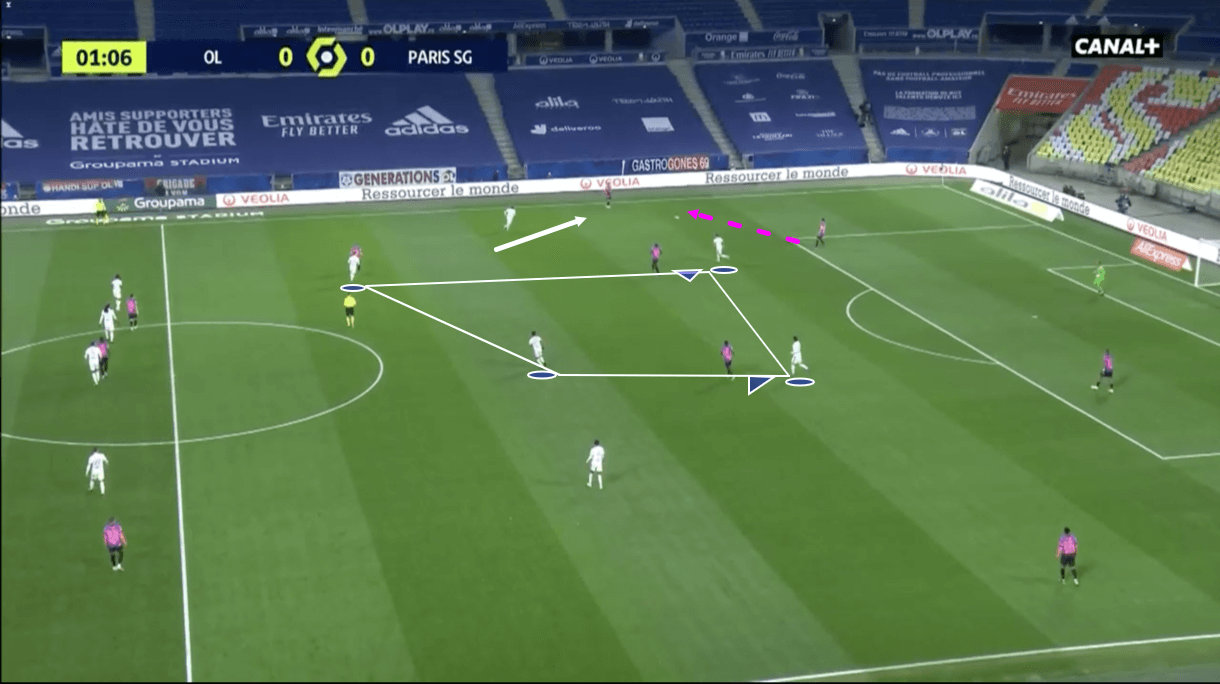
Firstly, figure 2 shows us how Lyon typically shaped up during the early stages of the opposition’s build-up play. Lyon played in a 4-3-3 but off the ball, their midfield tended to form a box like this, with Depay and one central midfielder forming one line, attempting to screen PSG’s two holding midfielders from receiving the ball. Meanwhile, the other central midfielder would drop in-line with Mendes, or later Guimarães, with one of them marking PSG’s ‘number 10’ very tightly.
The reason that Depay dropped like this is that Lyon were generally happy for PSG’s centre-backs to have the ball in this game, so the Dutchman didn’t need to press aggressively. Instead, he dropped into the midfield, boosting Lyon’s cover in the very centre of the pitch and attempting to block off this area during the build-up. By forming this box in the centre of midfield, Lyon’s goal was to prevent PSG from overloading them centrally. The goal was for Les Gones to usually have one free man in the centre due to these tactics or at the very least be even in numbers with PSG here.
If other PSG players, such as the left-winger who was usually Mbappé, attempted to boost PSG’s presence in the centre to overcome Lyon’s attempt to block off this area, the person marking them at that moment – in this case of Mbappé, the Lyon right-back – had license to stick tight to them, vacating their position and following them into the centre. So, it was clear that Lyon were focusing heavily on occupying the centre of the pitch, even if that meant weakening other positions for a moment.
In figure 2, we can also see that as the PSG full-backs received the ball in the build-up, they attracted pressure from the nearest Lyon winger. This pass was something of a pressing trigger for Lyon throughout the game. Toko Ekambi and Kadewere generally marked the PSG full-backs very tightly, to prevent PSG from building out through them too easily with the centre also blocked off, with the aim of either forcing PSG to play the ball backwards, which also led to some more aggressive pressure from Lyon at times, or forcing them to play the ball long, giving Lyon’s centre-backs a chance of winning the ball back via an aerial duel.
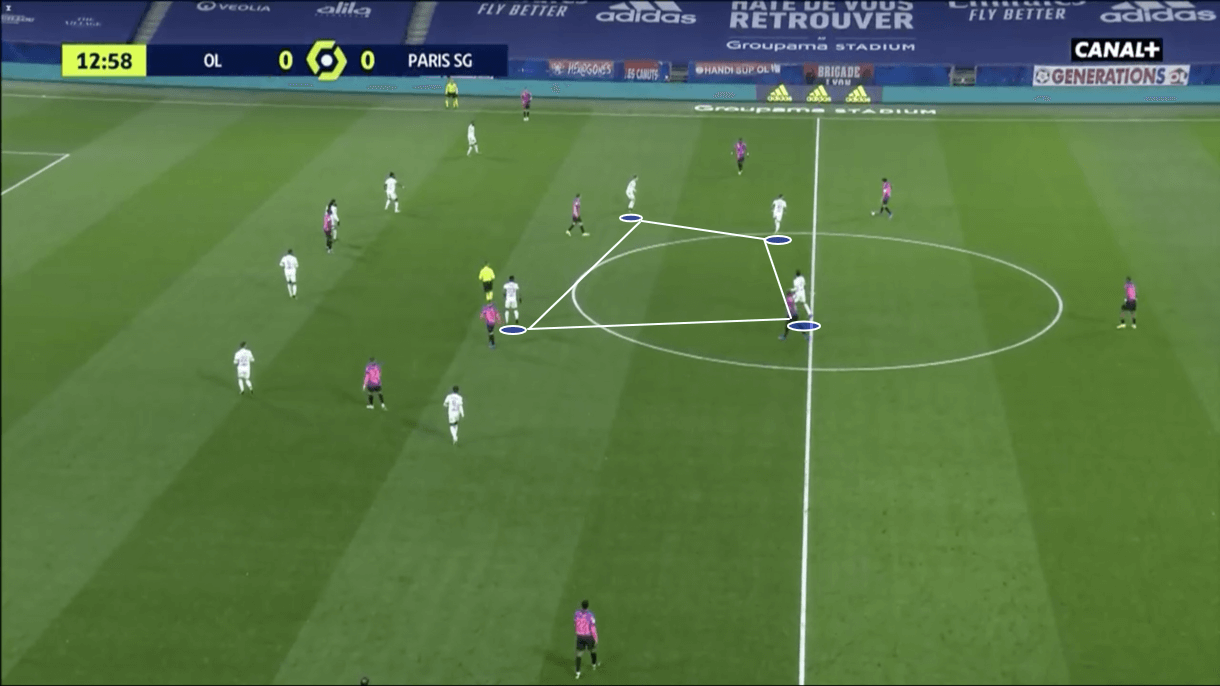
We can see another example of Lyon’s central midfield box in figure 3 but here Lyon are defending slightly deeper, with PSG at a more advanced stage of the attack. As PSG progressed to more advanced stages of the attack like this, they sometimes had more luck with playing into the centre despite Lyon’s efforts to congest this area and remain very compact. For example, as this particular passage of play moves on, Marquinhos plays the ball into Di María, who can be seen just behind Caqueret in the right half-space here.
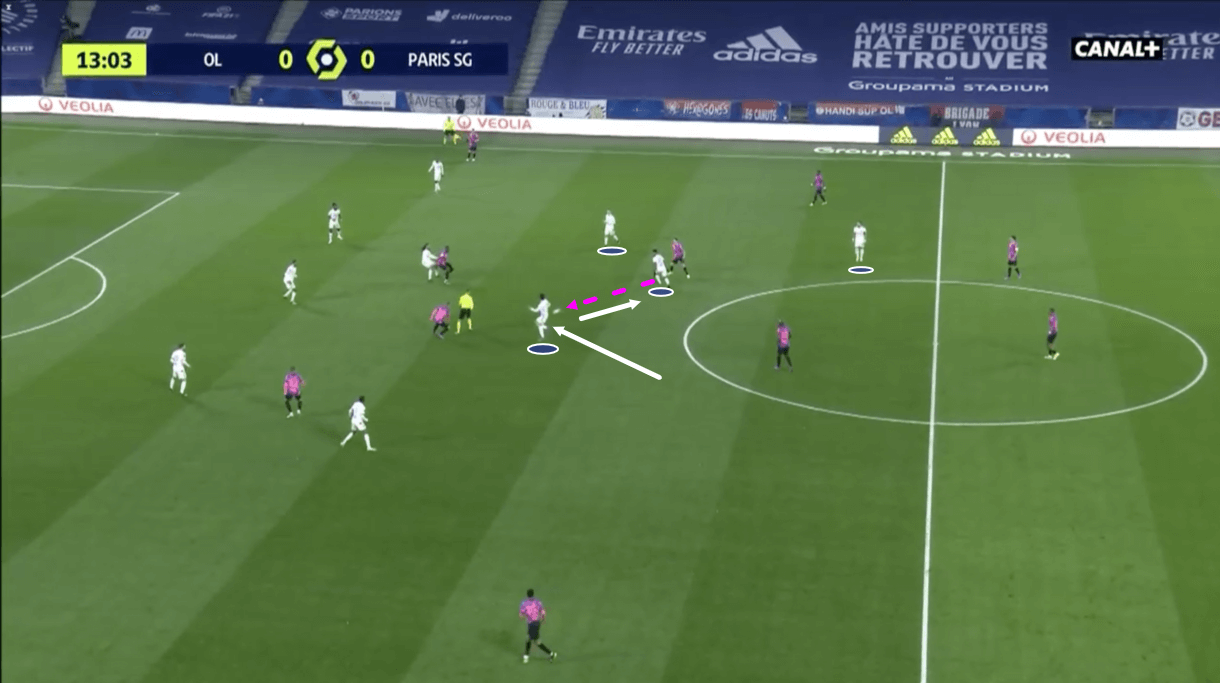
This pass to Di María dragged Mendes away from Verratti in central midfield, as he went to offer support on the Argentinian, however, this wasn’t enough to prevent Di María from turning quickly and playing the ball towards a seemingly free Verratti. This passage of play highlights an advantage of Lyon’s midfield box and how they congested the centre of the pitch with it. As Di María plays the ball towards a vacated Verratti, Paquetá managed to spot the danger and provide cover as he got back in time to intercept the pass.
This shows how difficult Lyon did effectively make it to play through the centre at times, thanks to their tactics.
PSG’s offensive tactics
Lyon’s defensive tactics evidently weren’t good enough, however, as PSG did manage to net four times in this contest, helping them to earn a relatively comfortable victory. It’s clear from the previous section that congesting the centre and utilising some strict marking all over the pitch were two key factors for Les Parisiens in defence in this one and PSG’s offensive tactics exploited the key weaknesses in Lyon’s gameplan expertly.
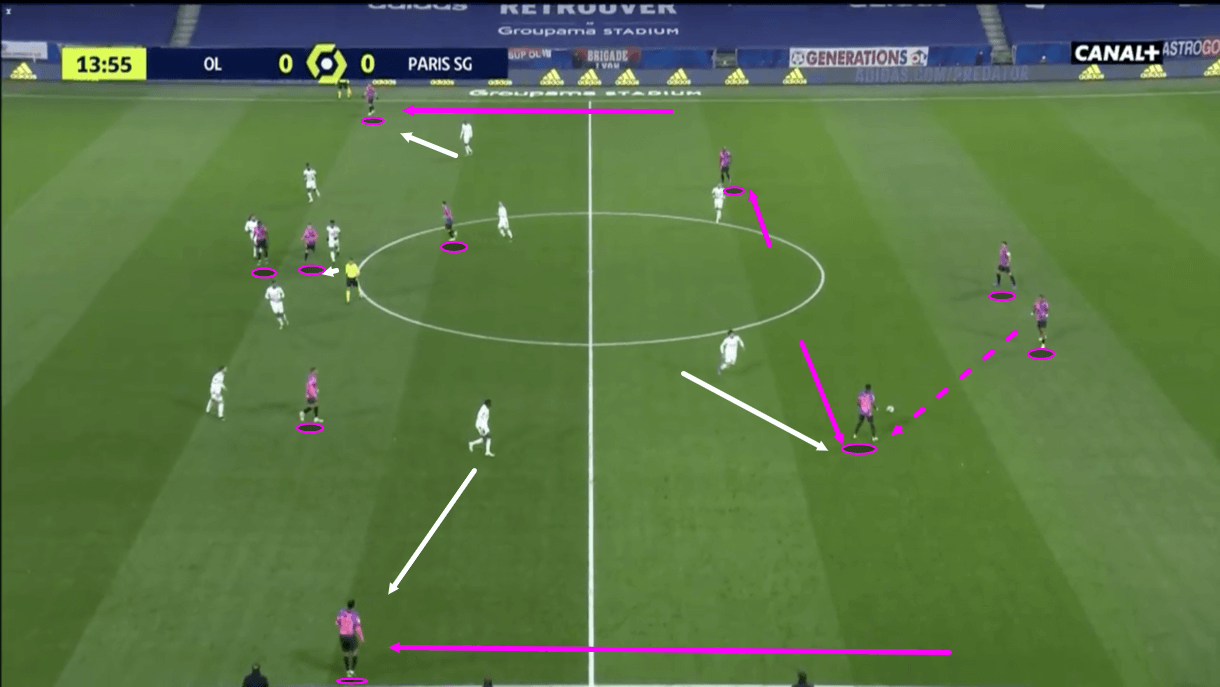
Firstly, effective off-the-ball movement and quick passing were arguably the biggest factors that led to PSG’s dominant win. Figure 5 shows an example of this via PSG’s build-up play leading up to Mbappé’s goal in the 15th minute.
We can see that both PSG’s left-back and right-back have pushed very high up the pitch, effectively making themselves the width-providers inside the opposition’s half. As mentioned, Lyon’s wingers were essentially in charge of these full-backs and as a result of this movement, they were forced to move very deep.
Additionally, we can see that PSG’s two holding midfielders have increased the distance between one another, to lose their markers due to the Lyon players’ focus of congesting the centre and not getting dragged out wide with the full-backs. This was intelligent movement from them and they often managed to free themselves up by either dropping between the two centre-backs or dropping into either side of the backline. After that, then they could carry the ball forward and/or pick out teammates in more advanced positions, availing of additional time that they had thanks to their movement out from the centre.
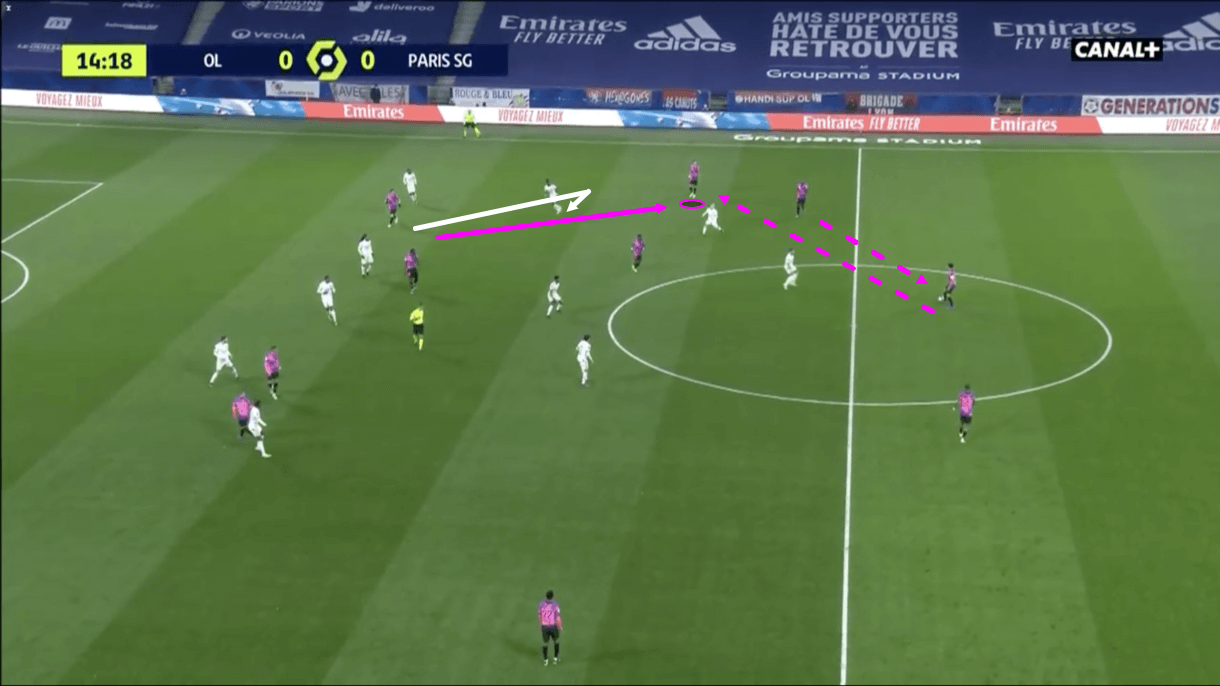
As this particular passage of play moves on, figure 6 shows us how Di María dropped deep and freed himself up too. Just before this image was taken, Di María was positioned far higher up the pitch, alongside the rest of PSG’s frontline. However, he ended up dropping deep to try and offer an option in more space to Pereira in the right holding midfield position.
As he dropped, he was followed by Lyon left-back Cornet but as Pereira didn’t immediately take up the short passing option of Di María due to Cornet’s presence, the left-back began to retreat. With the nearest central midfielder focused on occupying the centre, the nearest winger stuck deep marking Florenzi and now Cornet, the left-back, moving away, PSG quickly sent the ball straight back out to Di María, who now had more space and he went on to play the ball to Kean that led to the forward directly creating PSG’s first goal of the game.
This passage of play gives us a clear example of how PSG used the key aspects of Lyon’s defensive tactics against them at times in this game, manipulating their shape via off the ball movement and quick, intelligent passing.
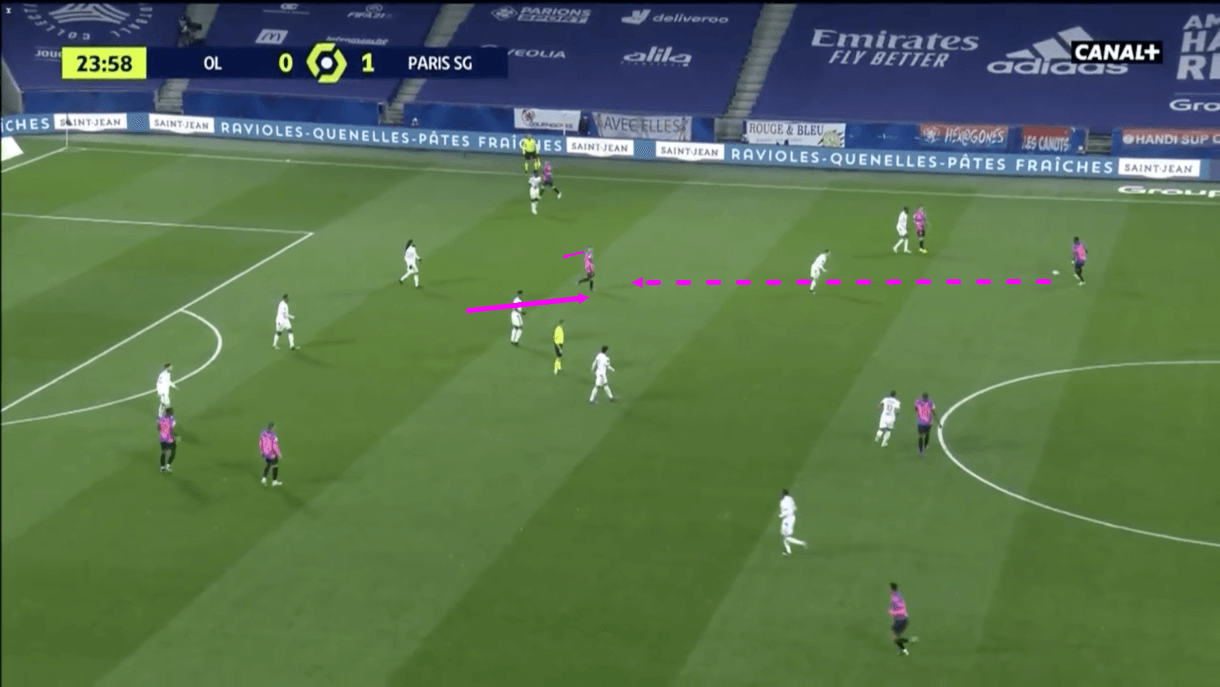
Figure 7 shows Verratti freeing himself up in between the lines and getting onto the end of a Gueye pass. The movement of players like Verratti, Di María and Mbappé in between the lines was constant and crucial for PSG in this win.
They gave Lyon’s defence and midfield a lot to think about throughout the game in terms of their movement and while the ‘10’, in this case, Verratti, was generally marked very tightly by Lyon’s holding midfielder, in this case, Mendes, the PSG attackers were constantly moving throughout the game, shifting from one side to the other, dropping deep and threatening to make runs in behind and this ultimately led to them finding space at times despite Lyon’s efforts, as Verratti did here.
Verratti was a very useful element of PSG’s gameplan on Sunday because of his intelligent movement in between the lines, his ability on the ball and his diligent scanning. We can see him scanning as he shifts into the right half-space here, ensuring that he has time and space to receive and turn, while also creating a picture in his mind of his surroundings. Thanks to these factors of his movement and on the ball ability, Verratti was very effective in terms of switching play, playing the final ball and providing an option in dangerous positions to deeper-positioned players in this game. He covered a lot of ground, popping up on the left, right and centre at different points and this unpredictability, which appeared well co-ordinated with his teammates, also helped.
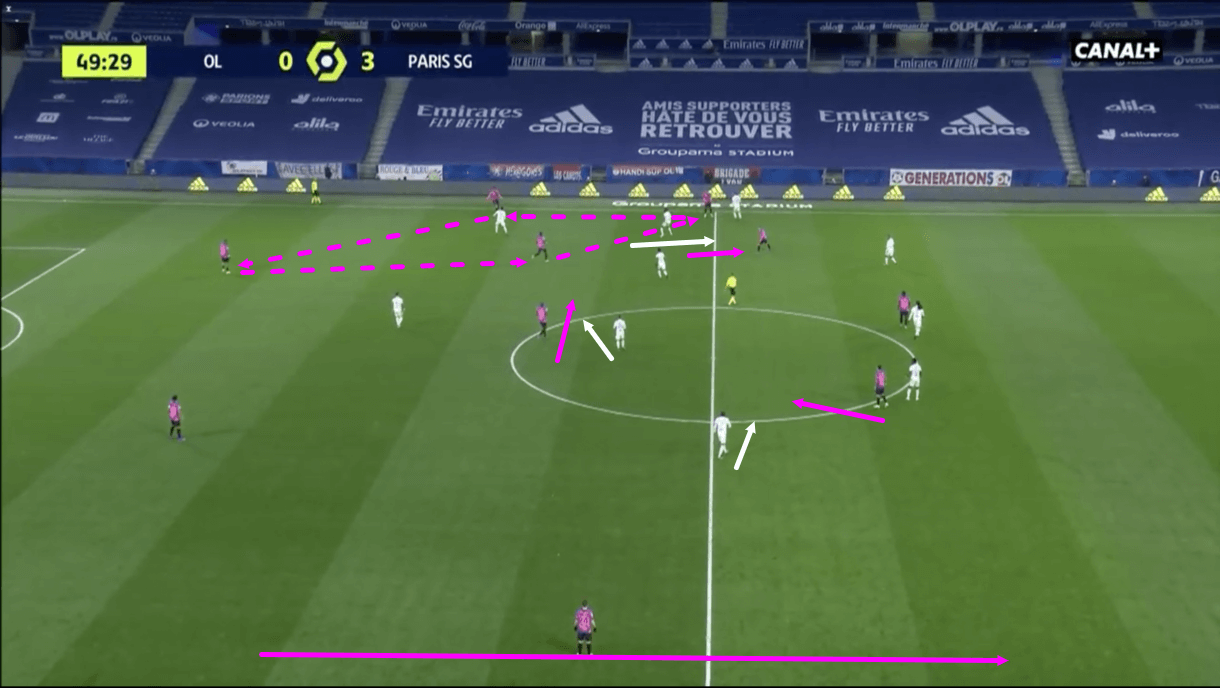
In figure 8, we can see an example of another aspect of PSG’s tactics in possession from Sunday’s win. Sometimes, during the build-up, they created an overload on the left-wing, with the aim of attracting pressure from enough Lyon players that right-back Florenzi would end up free and could be released into space following a quick switch of play.
In this particular example, Navas started the move from a goal-kick, playing the ball to left centre-back Kimpembe, who then quickly passed the ball to Gueye right ahead of him. As Gueye received the ball, Verratti dragged Kadewere away up the pitch just via his off-the-ball movement, as he was the closest player to Kadewere at that moment and the Lyon attacker wouldn’t allow him to move into too much space.
Gueye played the ball on to Mbappé, who played it back to Diallo at left-back. As this passing was happening, other PSG players came close to offer support, dragging more Lyon players over with them in the process, however, Florenzi held his width on the right and although this particular attack didn’t wield success, this move proved to be an effective one throughout this game in helping PSG to build-up effectively and utilise the overlapping full-back.
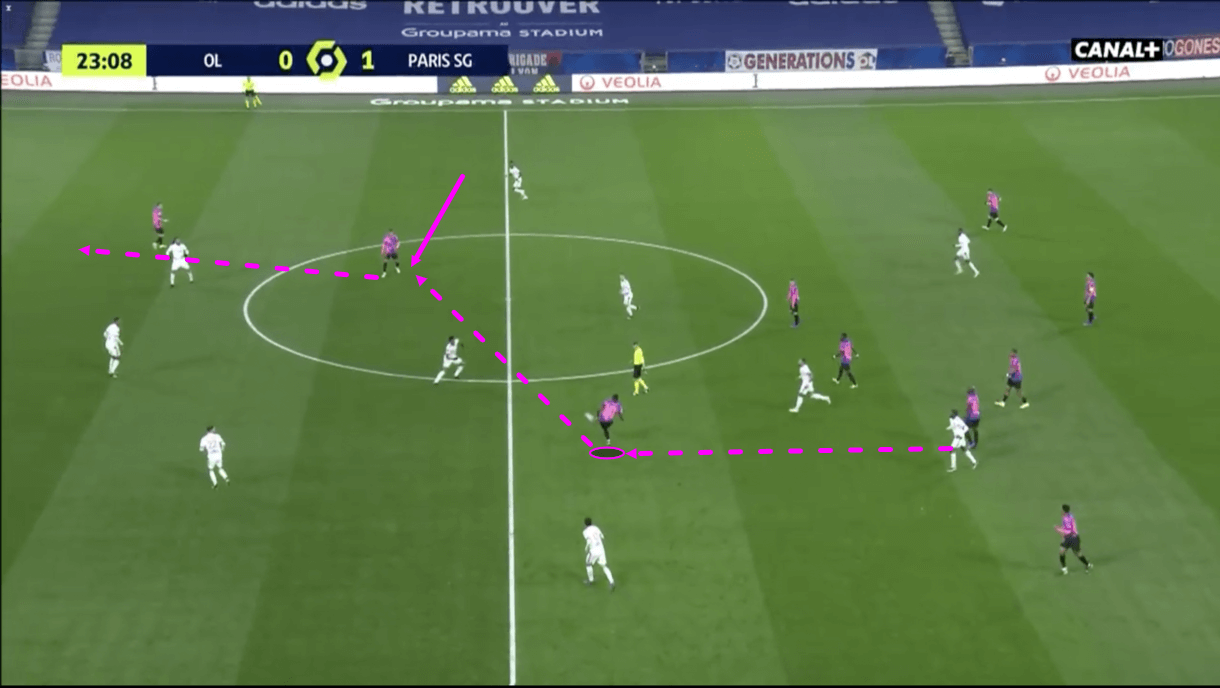
It’s worth noting, lastly, that PSG excelled in transition in this game. For example, just before figure 9 was taken, Les Parisiens won the ball back in midfield and the ball was quickly played forward to Kean here, who had very little pressure on him. As he received the ball, he spotted Mbappé’s movement in the centre of the pitch right behind Mendes and immediately picked him out with a pass. As the play then moves on, Mbappé slides a through ball into Di María’s path.
PSG created lots of goalscoring opportunities from counters versus Lyon, they were generally quicker to react in moments of transition, both in and out of possession and this could have played a part in Lyon’s struggle to win duels, which Garcia highlighted as a notable area of weakness after the game. Again, PSG exploited this weakness very effectively, as they did for others, proving their tactics to be well-thought-out and effective.
Lyon’s offensive tactics
It wasn’t all ‘defensive woes’ and nothing else for Lyon on Sunday, however, as they did manage to score two goals of their own. As well as that, while they only managed to take half as many shots as PSG, only one of their shots was off target, giving them a far better percentage of shots on target than their opponents.
So, did Lyon succeed in creating some high-quality chances despite their struggles off the ball and difficulties with gaining control of the game? Yes, we believe so. How did they do that? Well, firstly, let’s look at their typical offensive shape from Sunday.
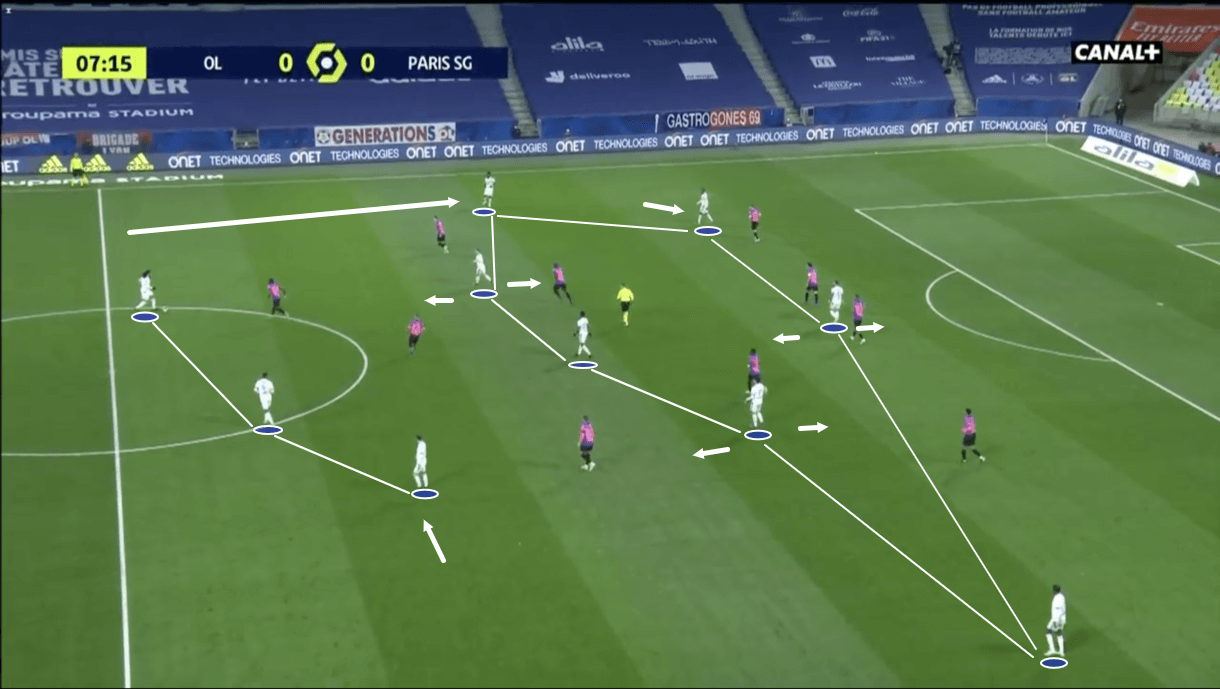
In figure 10, we can see how Lyon generally lined up on the ball versus PSG. Three of their back four, the two centre-backs and the right-back, tended to stay back, while the left-back, in this case, Cornet, provided a constant threat on the overlap throughout the game. This saw Toko Ekambi come inside quite often, joining Depay up front, while Kadewere also came central at times but with the right-back not overlapping, he had to hold the width a lot more than usual as well.
Additionally, the three-man midfield typically remained a three-man midfield, though the outside central midfielders, Caqueret and Paquetá, have license to push up further if the opportunity presented itself and they judged that to be the best course of action, which they did a couple of times.
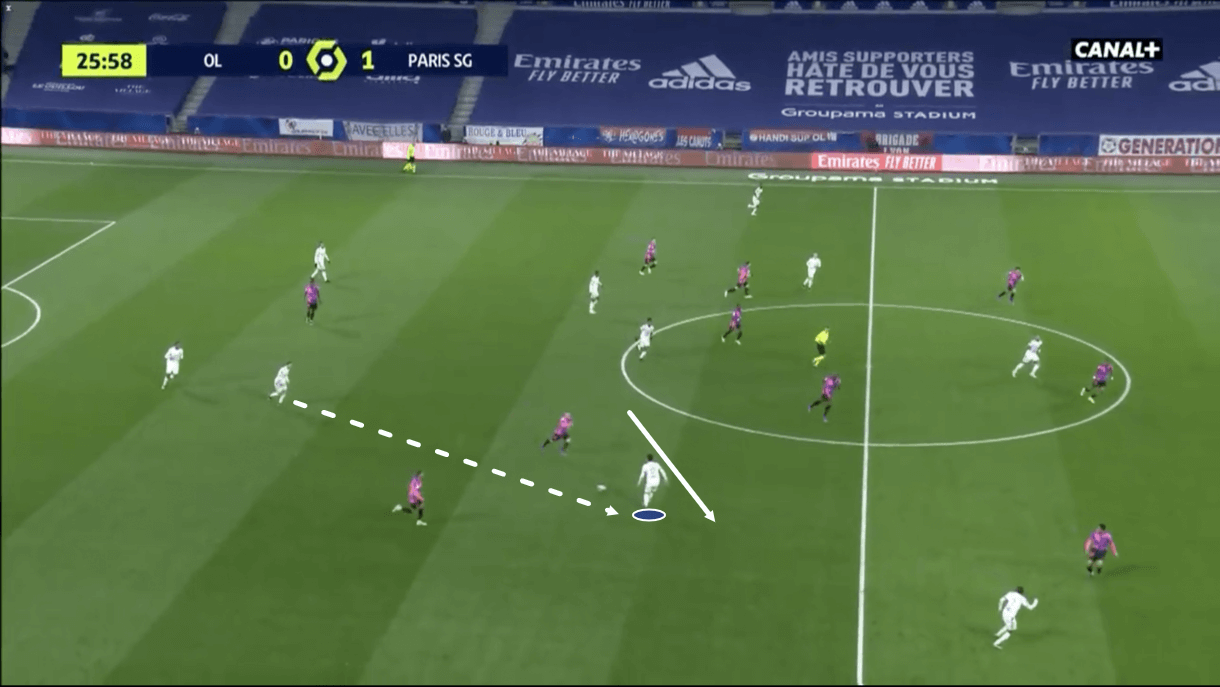
However, while Paquetá did offer something in the final third, where he really shone on Sunday was in the build-up. Lyon didn’t enjoy an awful lot of success in building out from the back in this one as PSG’s press was quite successful, however, some of the times that they did manage to build out from the back were aided significantly by Paquetá, his off-the-ball movement and his quality on the ball.
In figure 11, we see Paquetá receiving a pass just inside of his own half, however, it’s worth noting that he’s not receiving the ball in the very centre of the pitch, but slightly to the right of centre. Just before this image was taken, he was in a more central position but as the play moves on, he drifts away into this position we see him now, losing his marker, Verratti, and putting himself into a position to receive on the half-turn and act as the link man between the backline and the forwards, which is an important role that he accomplished well here and on several other occasions during this game.
Paquetá proved himself to be excellent at finding space and progressing play despite how difficult PSG made it for him and his teammates to do that.
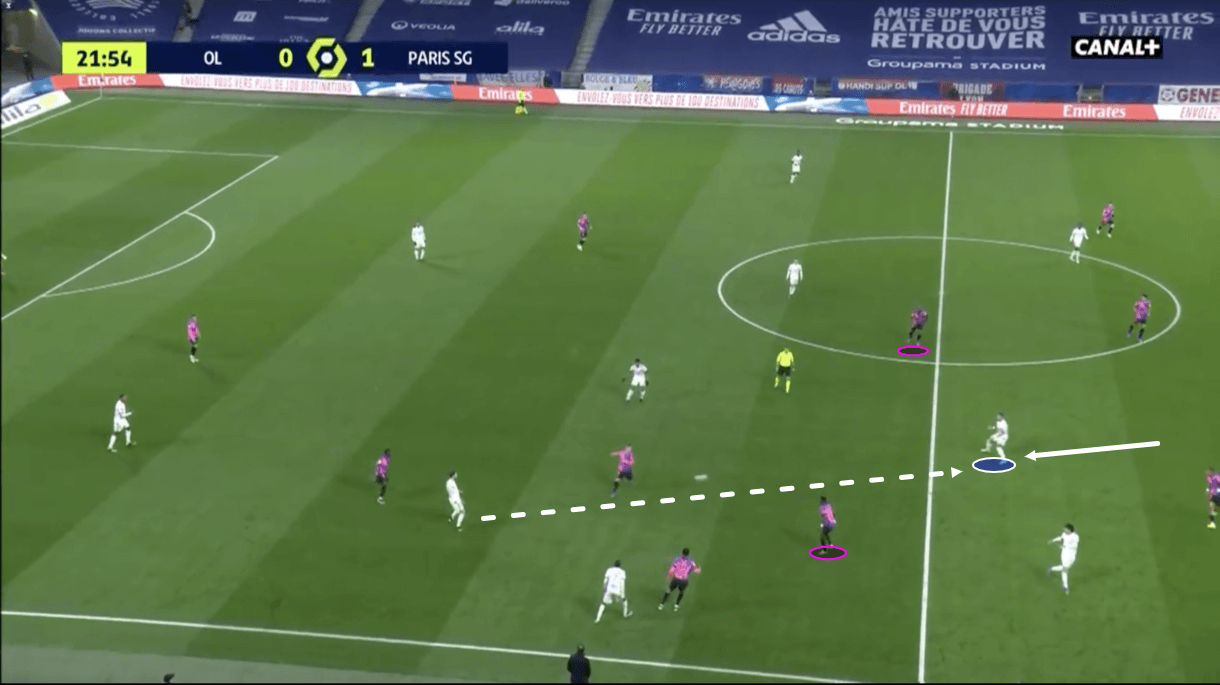
Movement in between the lines was also key for Lyon in building their successful attacks, as it often is. PSG made it difficult for them to do this as effectively as normal on Sunday but Les Gones did manage to do so at times, notably through Depay, who frequently drops off from his advanced centre forward position to boost Lyon’s numbers in midfield and create space for the likes of Toko Ekambi and Kadewere to potentially move into up front.
In figure 12, we can see one example of Depay receiving in between the lines on Sunday. In this particular image, we can see that the Dutchman dropped off and found himself right in the middle of PSG’s double-pivot, where he receives the ball well but quickly passes it and as play moves on, the Lyon attack ultimately fizzles out, however, the movement of Depay, as usual, was very helpful and effective at times.
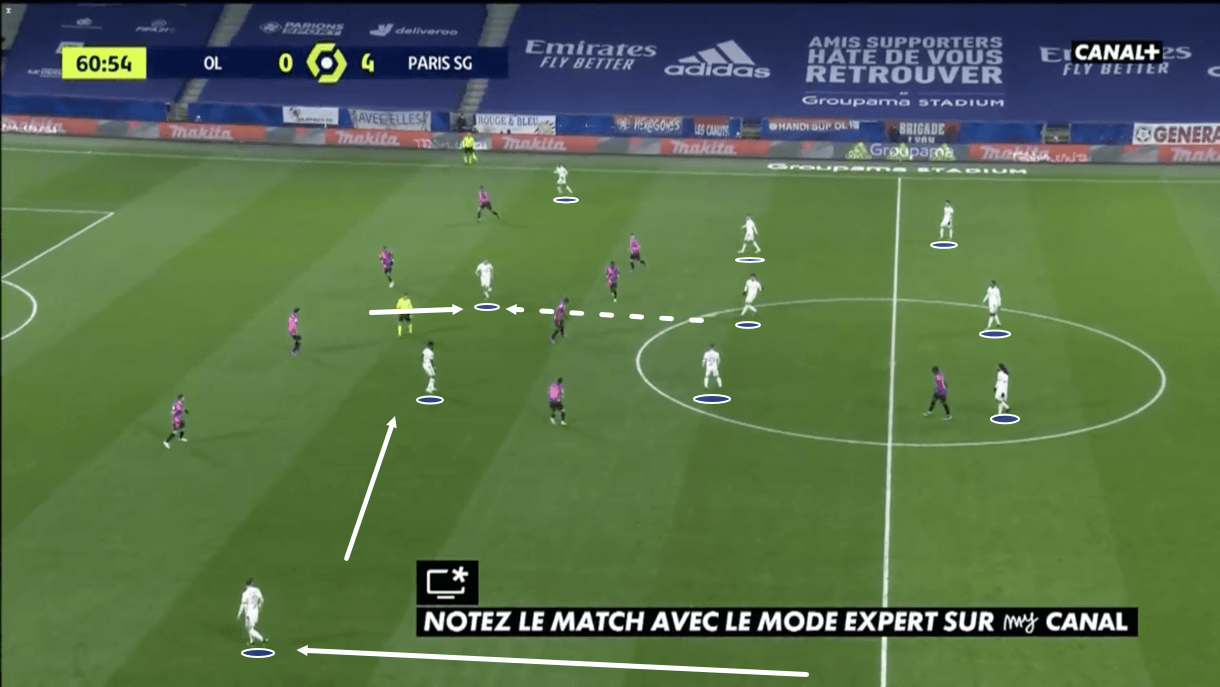
It wasn’t just Depay whose movement in between the lines was helpful for Lyon, however, as Slimani was also very effective in this area when he was introduced to the game in place of Depay. Garcia made some very effective substitutions and changes on the pitch that helped to turn the tide more in Lyon’s favour towards the end and Slimani was one of the substitutes who had the biggest impact.
In figure 13, we can see an example of how he found space in between the lines, along with Cornet, who played the same role that Toko Ekambi played in figure 10 of cutting inside from the left-wing, to make himself available for a very well-disguised Paquetá pass. Like Depay, Slimani’s movement in these areas was crucial for some of his side’s successful attacks.
PSG’s defensive tactics
Above, we mentioned that PSG made it very difficult for Lyon to build out from the back and to find space in between the lines. This was thanks to their defensive tactics which were successful at limiting Lyon’s volume of successful attacks on Sunday for large chunks of the game.
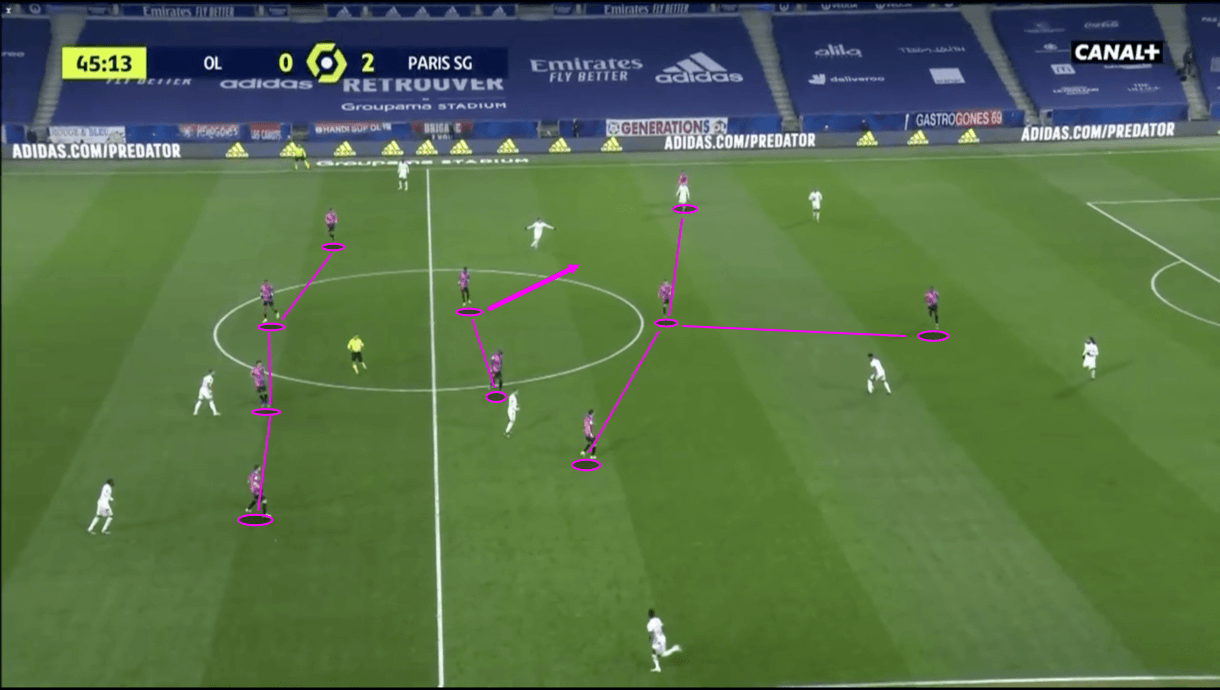
Firstly, in figure 14, we can see an example of PSG’s base 4-2-3-1 formation. It’s important to note that when the opposition were in possession of the ball with a chance of playing centrally, PSG were very organised and generally remained very vertically and horizontally compact. Les Parisiens’ goal at this point is not necessarily to dispossess but more to force the opposition to avoid playing through the centre. So, PSG congested this area off the ball, with the aim of forcing Lyon to play through the full-backs, which is where their pressing picks up a notch or two.
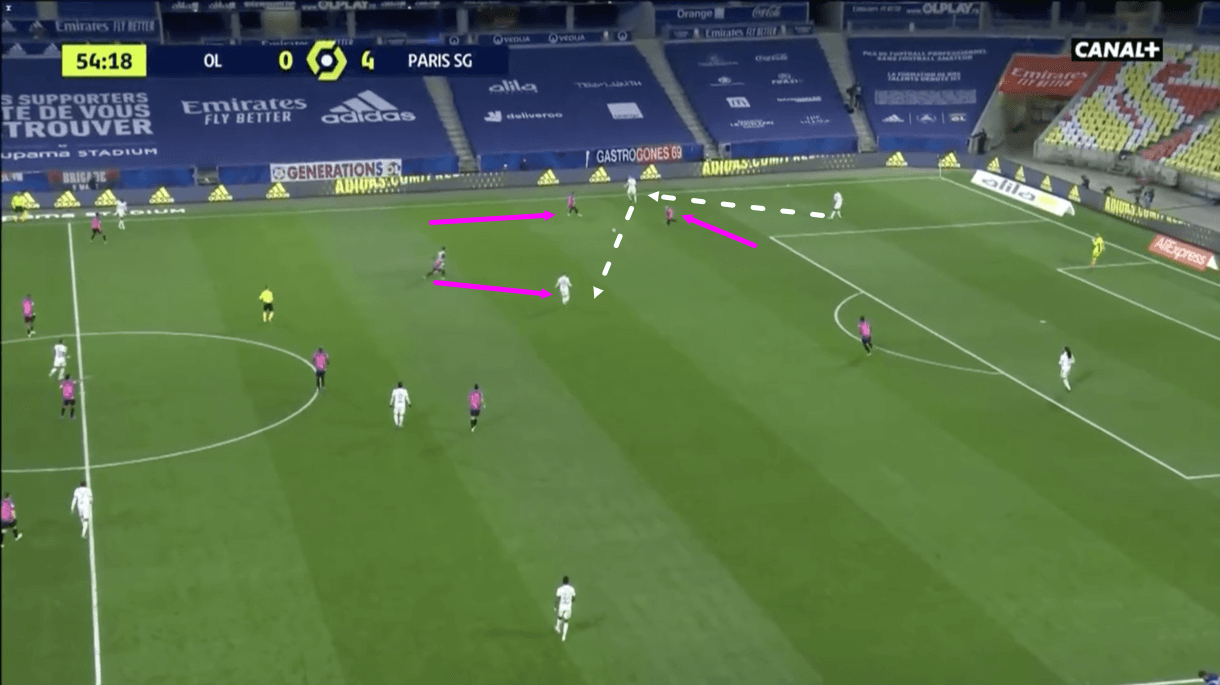
Figure 14 showed us how PSG congested the centre of the pitch, making it difficult for the opposition to build attacks through the middle of the park and figure 15 shows another example of this, in addition to how they successfully created chances for themselves via their aggressive pressing tactics.
A lot of the time, with the very centre of the pitch unavailable, Lyon were forced to play from the centre-back to one of the full-backs. As the full-back received the ball, that was a serious pressing trigger for PSG and as the image above shows, the man on the ball would get closed in on from all angles.
On this particular occasion, we can see that Gueye is positioned quite high as one Lyon central midfielder dropped deep to offer support to the man on the ball, it was very common to see one of Gueye or Pereira advancing their position during PSG’s press like this because it was also very common for one of Lyon’s central midfielders to drop deep during the build-up. The movement of PSG’s holding midfielders was generally quite effective at stifling the build-up to a good extent, however.
As the right-back attempts to find the holding midfielder, Gueye is alert to that pass and springs into action, closing down the intended ball-receiver and winning back possession for PSG. Winning the ball back in a dangerous position directly leads to a decent goalscoring opportunity here, as it did on a few occasions for PSG in this game, highlighting that their pressing was not just a useful defensive tool, but also an offensive one.
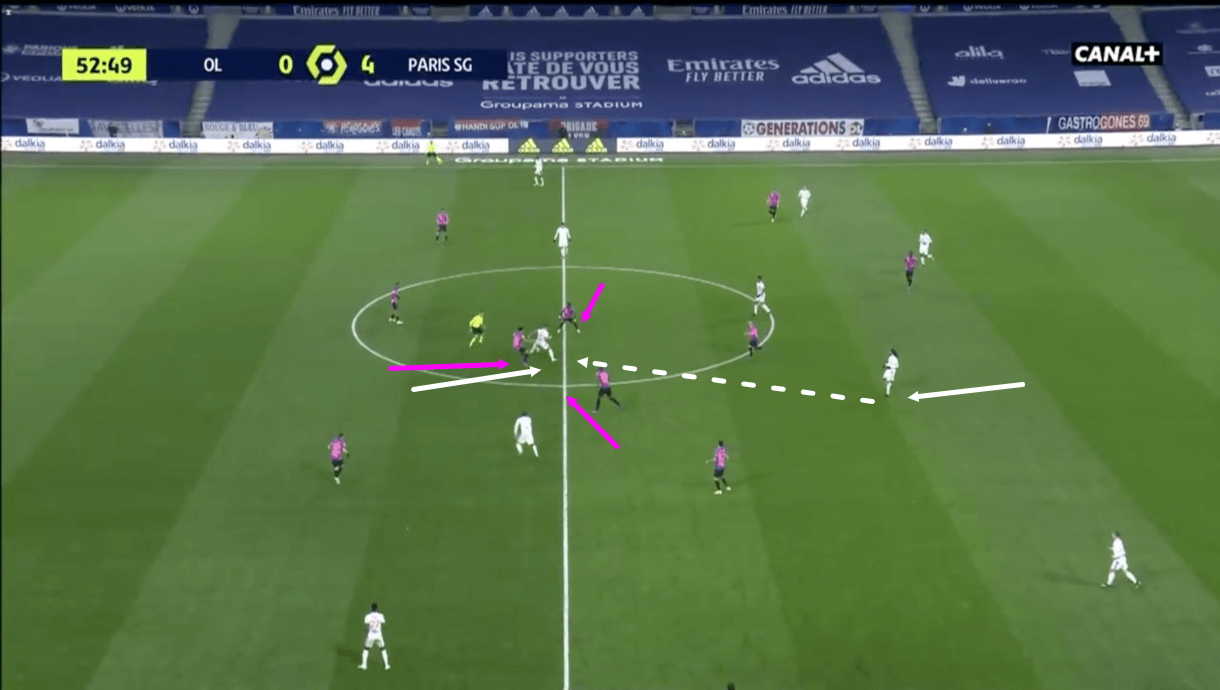
Lastly, in figure 16, we can see an example of how and why it was so difficult for Lyon’s attackers to impact the game from between the lines in this one – PSG were generally very aggressive about defending this area. They’ve had some weaknesses with defending this area during the 2020/21 campaign, however, they were much better at it in this fixture than they have been a lot of the time this term.
Just before this image was taken, Denayer carried the ball out from the back and found Depay dropping in between the lines. He played the ball forward to the attacker but Depay was followed closely by Marquinhos, who ultimately prevented him from turning, and his movement from the striker position to the area we see him in here also attracted the attention of both Gueye and Pereira, so he ends up getting closed in on from all angles, with little room to move. This isn’t the only time that a Lyon player was closed down like this in between the lines during this game, they effectively defended this area on a few occasions and this aspect of their defensive tactics was well-planned.
Conclusion
To conclude this tactical analysis piece, movement was a key theme to this game for both sides but PSG ultimately dominated in this area, pulling Lyon’s defence apart via intelligent off-the-ball movement and quick passing moves.
Lyon demonstrated some good play on occasion but PSG made life too difficult for them at times both on and off the ball, restricting their space in midfield, pressing aggressively on the full-back receiving the ball and when the ball was played in between the lines, as well as manipulating Lyon’s defensive shape with their quality on the ball and they came away from the game as the deserved victor.





Comments